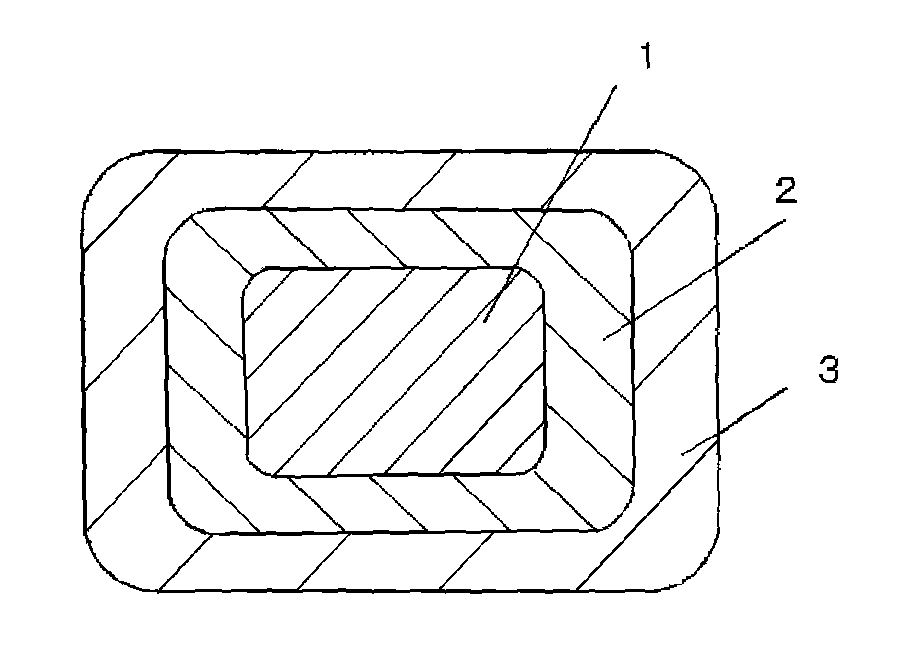Inverter surge-resistant insulated wire
a technology of insulated wire and inverter, which is applied in the direction of insulated conductors/cables, cables, insulation conductors, etc., can solve the problems of low voltage decay due to connection cables, high surge voltage, and high steep voltage rise, and achieve excellent insulation properties and high partial discharge inception voltage.
- Summary
- Abstract
- Description
- Claims
- Application Information
AI Technical Summary
Benefits of technology
Problems solved by technology
Method used
Image
Examples
example 1
[0088]A rectangular conductor (copper of oxygen content 15 ppm) was provided, which had a dimension of 1.8 mm×3.4 mm (thickness×width) and a chamfer radius r of 0.3 mm at four corners. In forming an enamel layer, the conductor was coated with a polyamideimide resin (PAI) varnish (manufactured by Hitachi Chemical Co., Ltd., trade name: HI406, dielectric constant ∈1: 3.9), by using a die with a shape similar to the shape of the conductor, followed by passing through an 8 m-long baking furnace set to 450° C., at a speed so that the baking time period would be 15 sec, thereby to form an enamel of thickness 5 μm, via this one step of baking. This step was repeated, to form an enamel layer with thickness 25 μm, thereby to obtain an enameled wire with the coating thickness of 25 μm.
[0089]The obtained enamel wire was used as a core wire, and a screw of the extruder having 30 mm fullflight, L / D=20, and compression ratio=3 was used. As the material, polyether ether ketone (PEEK) (manufactured...
example 5
[0091]An insulated wire composed of the PEEK extrusion-coated enamel wire was obtained in the same manner as in Example 1, except that polyimide (PI) resin varnish (manufactured by UNITIKA Limited., trade name: U imide, dielectric constant ∈1: 3.5) was used instead of the polyamideimide resin varnish as the enamel resin, and the thickness of the enamel layer and the extrusion-coated layer were changed to those shown in the following Table 2. The minimum of tensile elastic modulus at a range of 25 to 250° C. and the crystallinity measured by the above-described measuring method, of the extrusion-coated resin layer, are shown in Table 2. Extrusion was carried out under the conditions of extrusion temperature shown in Table 1.
example 6
[0092]An insulated wire composed of the modified PEEK extrusion-coated enamel wire was obtained in the same manner as in Example 1, except that modified polyether ether ketone (modified-PEEK) (manufactured by Solvay Specialty Polymers, trade name: AvaSpire AV-650, dielectric constant ∈2: 3.1, melting point: 340° C.) was used instead of the polyether ether ketone as the extrusion-coated resin, and the thickness of the enamel layer and the extrusion-coated layer were changed to those shown in the following Table 2. The minimum of tensile elastic modulus at a range of 25 to 250° C. and the crystallinity measured by the above-described measuring method, of the extrusion-coated resin layer, are shown in Table 2. Extrusion was carried out under the conditions of extrusion temperature shown in Table 1.
PUM
| Property | Measurement | Unit |
|---|---|---|
| thickness | aaaaa | aaaaa |
| thickness | aaaaa | aaaaa |
| tensile elastic modulus | aaaaa | aaaaa |
Abstract
Description
Claims
Application Information
 Login to View More
Login to View More - R&D
- Intellectual Property
- Life Sciences
- Materials
- Tech Scout
- Unparalleled Data Quality
- Higher Quality Content
- 60% Fewer Hallucinations
Browse by: Latest US Patents, China's latest patents, Technical Efficacy Thesaurus, Application Domain, Technology Topic, Popular Technical Reports.
© 2025 PatSnap. All rights reserved.Legal|Privacy policy|Modern Slavery Act Transparency Statement|Sitemap|About US| Contact US: help@patsnap.com


